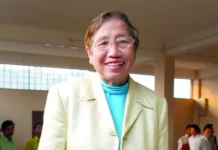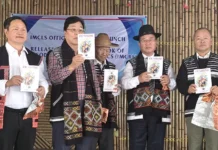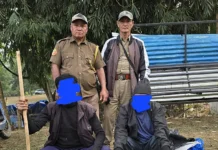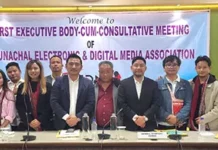[ RN Koley ]
The indigenous communities of Arunachal Pradesh consist of 26 cultural groups and 82 ethnic groups, on the basis of distinct linguistic identities. Thereby, Arunachal Pradesh is an abode of multi-ethnic, multi-faiths and beliefs and multicultural entity with its exotic natural surroundings. The people possess glorious and vibrating cultural heritage of arts and crafts, enchanting folk songs, folk dances, folklores depicting their lifestyle, customs, mingled with traditional wisdom. These are the basic components of socio-religio-cultural life of the people of Arunachal, essentially imbibed with religious belief and faith. Here people retain an interest in the art of living, expressed eloquently in their gestures, emotions, songs, dances, festivals and rituals. Their feelings of nature and behavioural pattern are truly instinctive over the centuries.
Their cultural heritage, age-old traditions and religious belief have stamped a profound impact on the temperament, philosophy and psychological perception. For that matter, there has all along been peace, tranquillity and complete harmony among the people professing various faiths. Festivals in Arunachal are the manifestation of different faiths to maintain their cognacy.
Arunachal is a paradise for unique cultural traditions depicting a variation of intangible and tangible cultural heritage of different ethnic groups of their own. These encompass aboriginal custom, tradition, heritage, belief, faith, religion, value judgment guided by tribal genesis. These had and have been professing by the indigenous people of Arunachal since time immemorial. The legacy of these incredible cultural ingredients is thus deep-rooted among diverse ethnic groups for augmenting their cultural fabric.
The people who are destined to be born as ‘tribal’ here are the privilege one’s on this planet as they are always in close proximity of nature. Characters, attitudes, living styles, house patterns, food habits, music, art, customs, traditions, culture, society, religious faith, economic pursuits, social fabrics of indigenous people are all depending upon the nature. Nature determines their thought and philosophy. The fundamental essence of their behaviour and characters are spontaneity, truthfulness, fearlessness. These are cardinal principles of their culture. They are fond of and enjoy happy-go-lucky freedom in their stages of life. They lead the way of life which is natural, original and spontaneous. They learn the lesson of life from nature and natural objects. This may be ruminated as ‘natural culture’. Thus, their faith may be termed as natural, and thereby scientific.
The social norms are mostly identical, which make them realistic to follow the natural way of life. Their social customs and traditions are the golden thread for maintaining the continuity of their generations. Tribal faith in the almighty is pure and genuine. Animism is basic feature of religious faith among the people, except some Buddhist tribes. To fulfil the ritualistic needs they worship mountains, rivers, stones, lakes, trees and visible objects, because they presume the presence of spirit in every object of the nature which are deemed fit for worship.
In Arunachal, the tribal way of life is thus unique, simple and custom-bound. They are of amicable, cheerful disposition, hospitable and also diligent. There is a traditional self-governing institution in villages, irrespective of tribe, for rural self-administration termed differently. The traditional institutions play day to day activities of community life in maintenance of peace and social equilibrium within the village periphery. These are the pillars of the society as all socio-cultural and socio-religious activities arbitrate around traditional village council.
To conceptualise them, one has to live with them, move with them, dine with them and share the happy or joyous and sad moments with them. Dr Verrier Elwin rightly envisaged the outlook – “one has to look the tribals by tribal eyes to understand them in proper perspective.”
Religious faith of indigenous people:
Man is a social animal. He lives in a society as an emotional creature. By instinct, man not only feels biological and economic needs, but also feels spiritual needs or religious needs to integrate his personality. Therefore, religion or faith is almost universal and pervasive institution in human society. Religious faith brings consolation to its adherents and gives them hope and courage at the point of distress through worshipping. Tribal people of Arunachal Pradesh also worship gods, goddesses and deities as per their own belief, faith, tradition and culture. Although basic tenants of all faiths and religions are the enrichment of humanities and human values. In that perspective every society should look for their own roots, own culture, own tradition, own belief and own faith to keep aside the cultural crisis or crisis of cultural identity. The new generation and youth of a large section of tribal society of Arunachal would find impetus from their own religious beliefs to promote of that indigenous faith and culture of Arunachal. An organisation – Indigenous Faith and Cultural Society of Arunachal Pradesh – was taken birth in 1999 which created a social movement to bring reminiscence in religious faith. Prior to that, Donyi-Polo Mission was established in 1979 to perpetuate the philosophy of religious faith. The tribes of Arunachal may be compartmentalised broadly into two: Buddhists and non-Buddhists. Buddhist communities are categorised into Mahayana and Hinayana sect. Mahayana sect includes Monpas, Sherdukpens, Membas, Khambas, Buguns, Sartangs who profess Lamaism form of Buddhism, while Hinayana sect includes Khamtis and Singphos, who profess the Theravada cult of Buddhism. Both the Buddhist sects have definite religious scriptures and places of worship. Thus, they have been maintaining their cultural legacy guided by Buddhism.
The non-Bodic people are initially animist following own religious beliefs. Out of which, a number of faith is developed in process of reviving their religious faith under the aegis of the Indigenous Faith and Cultural Society.
All forms of the indigenous faiths, beliefs and practices are mingled in revived religious faith constituting institutional form towards established religion. These emphasize genuinely on the spiritual, physical, philosophical and ideological realities behind the life of every day. Dr Verrier Elwin, the architect of tribal policy of India, articulated five essential qualities of religion in the tribal societies of Arunachal.
- i) There is a very general belief and faith on a supreme god who is just, benevolent and good. They believe in the existence of unseen world.
- ii) There is a genuine emphasis on the spiritual realities behind the life of every day in tribal religion. They believe on the spiritual cause of any tragedy misfortune and mishaps.
iii) Tribal religion is built up from an elaborate mythology as an outcome of meta physical thought. Myth is regarded as representing metaphorically a world picture and insight into life.
- iv) Tribal religion is associated with a social ethics and unites the tribe in its discipline and undoubtedly makes for a certain nobility of conduct. It incorporates the great tribal virtues – freedom, discipline, devotion to work, generosity, hospitality, truth and kindness.
- v) Tribal religion gives the people the power to reconcile themselves to the eternal emergencies of life.
One can trace all five essential qualities in true sense in theory and also in practice in indigenous faiths and beliefs. This tribal religion consisted of belief in supernatural or spiritual beings which coins with orthodox concept of religion propagated by many thinkers and theologists. All forms of indigenous faiths, beliefs, practices, numerous customs, laws, taboos, rituals and social doctrines constitute the tribal religion an outcome of evolutionary mechanism.
Before independence tribal people of Arunachal had hardly concrete conception to the term ‘religion’. Even they were not acquainted with the word ‘religion’. After getting independence and with the spread of education in this territory the indigenous people got the opportunity to mix up with the outside world, other communities and different ethnic groups. Tribal people had been undergoing psychological pressure from the outside world in course of their inquisitive search. They observe grandiose temples, rich theological literature and written religious scriptures of other communities and religions. PN Luthra observed – “He thus become vulnerable to frustration and inferiority complexes which can lead to his urge to shed his own faiths and adopt those of others. Happily this has been avoided in NEFA because the administration has taken pains to generate confidence among the people for their own religious tradition.”
It is pertinent to mention that the then NEFA administration put sincere emphasis to pay respect for the tribal way of life based on indigenous faith as their initial administrative policy in those days. They took up adequate endeavours to the growth and evolution of the tribal religion with futuristic outlook and vision. They promulgated appropriate policy of encouraging the tribal people to promote their indigenous religious faiths, myths and legends existed in the form of oral literature. To strengthen the people’s faiths and culture towards religious chord, the then administration rendered yeoman support to the people of this hilly region to develop confidence and pride in their own indigenous faiths, beliefs and tradition invariably.
Besides non-interference policy to develop tribal culture by the administration pioneer anthropologists and intellectuals such as GDS. Dunbar, ET Dalton, A Hamilton, A Mackenzie, C Van Furer Haimendorf, Verrier Elwin, made trips in this area and contributed enlightened writings. They were instrumental to form positive impetus on religious faith, beliefs and religion. As part of that administrative policy, the research department was established in 1951 and reorganised in 1953 under the guidance and captaincy of eminent anthropologist Dr Verrier Elwin for preserving, protecting and promoting tribal culture as a whole. These made serious motivation among the people for forming earnest thinking wave towards spiritual sense. Many educated people and young intelligentsia started writings on their own tradition, culture and religion.
In the process of historical circumstances the Adis, a blanket name of a number of sub-groups in the Siang valley, first received the touch of Britishers and thereby got light of education prior to independence. It is probably Adis who acquired religious consciousness first, prior to Buddhist communities. They were curious to know who was the creator and controller of the phenomena of the nature around them. This inquisitive curiosity led them to invent a number of explanations in the form of myths which were imbibed with the origin of an established religion Donyi Poloism. Thus search for institutional form of religion based on their indigenous faith was started. It gave the individual a sense of identity. Since time immemorial it has been functioning as an important agency of social control which is the fundamental tenant of religion.
These developments created an impact among the all tribes who called themselves descendants of Abotani. Thus, religious movement was spread towards reformation and revival of the indigenous faiths among other ethnic groups and led to develop Rangfraism among Tangsas, Intayaism among Idu Mishmis, and so on. Consequent upon the impact of emergence of Donyi-Polosim institutional form of worship has been developed. The people started to worship in place called Nyde Namlo of Nyishi, Meder Nello of Apatani, Gangging of Adi, Kargo Gamgi of Galo community, etc.
In continuation of the traditional religion of the people myths play a very significant role in forming religious perception, which decode the origin of the world, origin of god and origin of living beings including human beings. Sometimes these myths came in poetic form to decipher the socio-cultural traditions of the people. All ritualistic activities in religious practices are performed by priests known as Miri, Nyibo, etc. Magico-religious practices and healing also incorporate the indigenous faith. Taboo is also a part of the religious practices observed by the people as ethical code of conduct.
Conclusion
Among tribal communities of Arunachal, indigenous faith or religion identify the individual with group, supports him in uncertainty, console him in disappointment, enhance him morale and provide him with elements of identity. It inculcates the unity and stability of society by generating social control and values, providing means for overcoming guilt and alienation. All these essence of indigenous faiths or tribal religion are distinctly deep rooted in the mind of people. It has served the basic functions as mentioned hereunder categorically –
- a) Integration of individuals and the society.
- b) Role in social stability.
- c) Role in bringing morality.
- d) Role to determine human’s social behaviour.
- e) Role to encourage the welfare activities.
- f) Role to form organisation bodies.
- g) Role to develop a sense of fear.
- h) Role to develop artistic base and social security.
Religion here has often been a driving force in reformation of social abuse and bringing socio-cultural unity. (RN Koley is former culture assistant director of the research department.)




